
|
|
Lion's Ear (Leonotis leonurus). Hummingbird on flowers
|
Lion's Ear - Wild Dagga - Leonotis leonurus
Leonotis leonurus, also known as Lion's
Ear, Lion's Tail and Wild Dagga, is a plant species in the Lamiaceae (mint) family. The plant is a broadleaf evergreen large shrub native to South Africa and southern Africa, where it is very common. It is known for its medicinal and mild psychoactive properties. The main psychoactive component of Leonotis leonurus is leonurine.
The name Leonotis comes from the Greek leon meaning lion and otis meaning ear, alluding to the resemblance of the corolla to a lion's ear. leonurus = lion-coloured.
Common Names: Lion’s Ear, Lion’s Tail, Wild Dagga, Dacha, Daggha (Africa), Wild
Hemp, Minaret Flower, Flor de Mundo, Mota (Mexico).
The wild dagga is a robust shrub which grows up to 2-3m tall and 1.5m wide. It is common and widespread throughout South Africa and grows amongst rocks in
grassland. The medium-dark green 10-20–10 cm long leaves are narrow, rough
above, velvety below, with serrate edges and aromatic when crushed. The plant has tubular orange flowers in tiered whorls, typical to the mint family, that encircle the square stems. They rise above the foliage mass during the summer season, with flowering continuing into winter in warmer
climates. A white variety (known colloquially as 'Alba'), as well as a yellow variety also
exist.
In its native habitats Leonotis leonurus attracts nectivorous birds (mainly sunbirds), as well as various insects such as butterflies. The flowers' mainly orange to orange-red colour and tubular shape are indicative of its co-evolution with African sunbirds, which have curved bills suited to feeding from tubular flowers.
L. leonurus favors warm, dry climates and is
drought-tolerant, though it may be grown in almost any temperate environment including
shrublands, grasslands, and swamplands. Leonotis leonurus can especially be found in other subtropical and Mediterranean climate regions beyond South Africa such as
California, Mexico, Hawai, and the Caribbean, and has become naturalized in Western Australia and New South Wales in
Australia. While it can grow in the spring and summer months in temperate climes if well protected and in full
sun, it does not endure frost well and may not survive winter unless brought
indoors.
Leonotis leonurus is cultivated as an ornamental plant for its copious orange blossom spikes and accent or screening qualities for use in gardens and
parks. It is a moderate drought tolerant plant, and a nectar source for birds and butterflies in landscape
settings.
Leonotis leonurus propagates via seeds that, in temperate climates, must be sown indoors before the last frost or outdoors after the last
frost. To collect seeds from the plant, allow the seedheads to dry before
collection. If properly cleaned, the seeds can be successfully stored. Propagateó
allso from cuttings or by dividing up large clumps. In warmer climates, the shrub can grow in the
wild.
Leonotis leonurus has long been used in traditional African herbal medicine. The
leaves and roots of Leonotis leonurus contain the medicinal constituents that
make wild dagga an often-used remedy for a wide variety of ailments including
fevers, headaches, dysentery, flu, chest infections, epilepsy, constipation, delayed
menstruation, intestinal worms, spider bites, scorpion stings, hypertension and
snakebites. Externally, it is often used for hemorrhoids, eczema, skin rashes and
boils.
Its leaves and flowers have been used regularly in some African tribes as a medicinal tea that can induce a hypnotic mood and relieve anxiety and
depression. Many believe that the trance state induced by drinking the tea can help a person overcome emotional trauma as
well.
One experimental animal study suggests that "the aqueous leaf extract of Leonotis leonurus possesses
antinociceptive, antiinflammatory, and hypoglycemic properties; thus lending pharmacological credence to folk usage of the herb in the management
and/or control of painful, arthritic, and other inflammatory conditions, as well as for
adult-onset, type-2 diabetes mellitus in some communities of South Africa."
An animal study in rats indicated that in high doses, lion's tail has significant toxicological adverse effects on
organs, red blood cells, white blood cells and other important bodily functions.
The dried leaves and flowers have a mild calming effect when
smoked. In some users, the effects have been noted to be similar to the cannabinoid THC found in
Cannabis, except that it has a much less potent high. It has also been reported to cause mild
euphoria, visual changes, dizziness, nausea, sweating, sedation and
lightheadedness. The main psychoactive component of Leonotis leonurus is the active alkaloid
leonurine. Some cultures have been known to smoke it with cannabis or as a marijuana
substitute; we do not advocate this use of the plant and all information herein is provided for historical and educational
purposes.
In Africa, the Hottentot tribe and the Bushmen are known to smoke the buds and leaves of the wild dagga plant as
inebriants, either alone or mixed with tobacco. L. leonurus is used by the Kaffirs for recreational
purposes, and the Nama tribespeople chew quids of powdered leaves to produced psychoactive
effects. Similarly, in Mexico where wild dagga is known as flor de mundo (“flower of the
world”) and mota (a colloquial name for marijuana), the plant is used as a
Cannabis.
Source:
http://en.wikipedia.org/wiki/Leonotis_leonurus
http://www.plantzafrica.com/plantklm/leonotisleon.htm
http://entheology.com/plants/leonotis-leonurus-lions-tail/
http://www.wisegeek.com/
what-are-the-medical-uses-of-leonotis-leonurus.htm#didyouknowout
